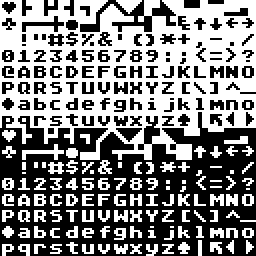Overview
There were several variations of display code, notably the 63-character character set, and the 64-character character set. There were also 'CDC graphic' and 'ASCII graphic' variants of both the 63- and 64-character sets. The choice between 63- or 64-character character set, and between CDC or ASCII graphic was site-selectable. Generally, early CDC customers started out with the 63-character character set, and CDC graphic print trains on their line printers. As time-sharing became prevalent, almost all sites used the ASCII variant - so that line printer output would match interactive usage. Later CDC customers were also more likely to use the 64-character character set.
A later variation, called 6/12 display code, was used in the Kronos and NOS timesharing systems in order to support full ASCII capabilities. In 6/12 mode, an escape character (the circumflex, octal 76) would indicate that the following letter was lower case. Thus, upper case and other characters were 6 bits in length, and lower case characters were 12 bits in length.
The PLATO system used a further variant of 6/12 display code. Noting that lower case letters were most common in typical PLATO usage, the roles were reversed. Lower case letters were the norm, and the escape character preceded upper case letters.
The typical text file format used a zero-byte terminator to signify the end of each record. The zero-byte terminator was indicated by, at least, the final twelve bits of a 60-bit word being set to zero. [1] The terminator could actually be anywhere from 12- to 66-bits long - depending on the length of the record. This caused an ambiguity in the 64-character character set, when a colon character needed to be the final character in a record. In such cases a blank character was typically appended to the record after the trailing colon.

ASCII, an acronym for American Standard Code for Information Interchange, is a character encoding standard for electronic communication. ASCII codes represent text in computers, telecommunications equipment, and other devices. ASCII has just 128 code points, of which only 95 are printable characters, which severely limit its scope. The set of available punctuation had significant impact on the syntax of computer languages and text markup. ASCII hugely influenced the design of character sets used by modern computers, including Unicode which has over a million code points, but the first 128 of these are the same as ASCII.

In computing and electronic systems, binary-coded decimal (BCD) is a class of binary encodings of decimal numbers where each digit is represented by a fixed number of bits, usually four or eight. Sometimes, special bit patterns are used for a sign or other indications.
In mathematics and computing, the hexadecimal numeral system is a positional numeral system that represents numbers using a radix (base) of sixteen. Unlike the decimal system representing numbers using ten symbols, hexadecimal uses sixteen distinct symbols, most often the symbols "0"–"9" to represent values 0 to 9 and "A"–"F" to represent values from ten to fifteen.
In computer programming, Base64 is a group of binary-to-text encoding schemes that transforms binary data into a sequence of printable characters, limited to a set of 64 unique characters. More specifically, the source binary data is taken 6 bits at a time, then this group of 6 bits is mapped to one of 64 unique characters.
The null character is a control character with the value zero. It is present in many character sets, including those defined by the Baudot and ITA2 codes, ISO/IEC 646, the C0 control code, the Universal Coded Character Set, and EBCDIC. It is available in nearly all mainstream programming languages. It is often abbreviated as NUL. In 8-bit codes, it is known as a null byte.
uuencoding is a form of binary-to-text encoding that originated in the Unix programs uuencode and uudecode written by Mary Ann Horton at the University of California, Berkeley in 1980, for encoding binary data for transmission in email systems.
ISO/IEC 8859-6:1999, Information technology — 8-bit single-byte coded graphic character sets — Part 6: Latin/Arabic alphabet, is part of the ISO/IEC 8859 series of ASCII-based standard character encodings, first edition published in 1987. It is informally referred to as Latin/Arabic. It was designed to cover Arabic. Only nominal letters are encoded, no preshaped forms of the letters, so shaping processing is required for display. It does not include the extra letters needed to write most Arabic-script languages other than Arabic itself.
Shift JIS is a character encoding for the Japanese language, originally developed by the Japanese company ASCII Corporation in conjunction with Microsoft and standardized as JIS X 0208 Appendix 1.

The ATASCII character set, from ATARI Standard Code for Information Interchange, alternatively ATARI ASCII, is a character encoding used in the Atari 8-bit home computers. ATASCII is based on ASCII, but is not fully compatible with it.

ArmSCII or ARMSCII is a set of obsolete single-byte character encodings for the Armenian alphabet defined by Armenian national standard 166–9. ArmSCII is an acronym for Armenian Standard Code for Information Interchange, similar to ASCII for the American standard. It has been superseded by the Unicode standard.

Shift Out (SO) and Shift In (SI) are ASCII control characters 14 and 15, respectively. These are sometimes also called "Control-N" and "Control-O".
Intel hexadecimal object file format, Intel hex format or Intellec Hex is a file format that conveys binary information in ASCII text form, making it possible to store on non-binary media such as paper tape, punch cards, etc., to display on text terminals or be printed on line-oriented printers. The format is commonly used for programming microcontrollers, EPROMs, and other types of programmable logic devices and hardware emulators. In a typical application, a compiler or assembler converts a program's source code to machine code and outputs it into a object or executable file in hexadecimal format. In some applications, the Intel hex format is also used as a container format holding packets of stream data. Common file extensions used for the resulting files are .HEX or .H86. The HEX file is then read by a programmer to write the machine code into a PROM or is transferred to the target system for loading and execution. There are various tools to convert files between hexadecimal and binary format, and vice versa.
The octet is a unit of digital information in computing and telecommunications that consists of eight bits. The term is often used when the term byte might be ambiguous, as the byte has historically been used for storage units of a variety of sizes.
A six-bit character code is a character encoding designed for use on computers with word lengths a multiple of 6. Six bits can only encode 64 distinct characters, so these codes generally include only the upper-case letters, the numerals, some punctuation characters, and sometimes control characters. The 7-track magnetic tape format was developed to store data in such codes, along with an additional parity bit.

Extended ASCII is a repertoire of character encodings that include the original 96 ASCII character set, plus up to 128 additional characters. There is no formal definition of "extended ASCII", and even use of the term is sometimes criticized, because it can be mistakenly interpreted to mean that the American National Standards Institute (ANSI) had updated its ANSI X3.4-1986 standard to include more characters, or that the term identifies a single unambiguous encoding, neither of which is the case.
The PDP-11 architecture is a 16-bit CISC instruction set architecture (ISA) developed by Digital Equipment Corporation (DEC). It is implemented by central processing units (CPUs) and microprocessors used in PDP-11 minicomputers. It was in wide use during the 1970s, but was eventually overshadowed by the more powerful VAX architecture in the 1980s.
The MARC-8 charset is a MARC standard used in MARC-21 library records. The MARC formats are standards for the representation and communication of bibliographic and related information in machine-readable form, and they are frequently used in library database systems. The character encoding now known as MARC-8 was introduced in 1968 as part of the MARC format. Originally based on the Latin alphabet, from 1979 to 1983 the JACKPHY initiative expanded the repertoire to include Japanese, Arabic, Chinese, and Hebrew characters, with the later addition of Cyrillic and Greek scripts. If a character is not representable in MARC-8 of a MARC-21 record, then UTF-8 must be used instead. UTF-8 has support for many more characters than MARC-8, which is rarely used outside library data.
BCD, also called alphanumeric BCD, alphameric BCD, BCD Interchange Code, or BCDIC, is a family of representations of numerals, uppercase Latin letters, and some special and control characters as six-bit character codes.

The ZX80 character set is the character encoding used by the Sinclair Research ZX80 microcomputer with its original 4K BASIC ROM. The encoding uses one byte per character for 256 code points. It has no relationship with previously established ones like ASCII or EBCDIC, but it is related though not identical to the character set of the successor ZX81.

The ZX81 character set is the character encoding used by the Sinclair Research ZX81 family of microcomputers including the Timex Sinclair 1000 and Timex Sinclair 1500. The encoding uses one byte per character for 256 code points. It has no relationship with previously established ones like ASCII or EBCDIC, but it is related though not identical to the character set of the predecessor ZX80.








